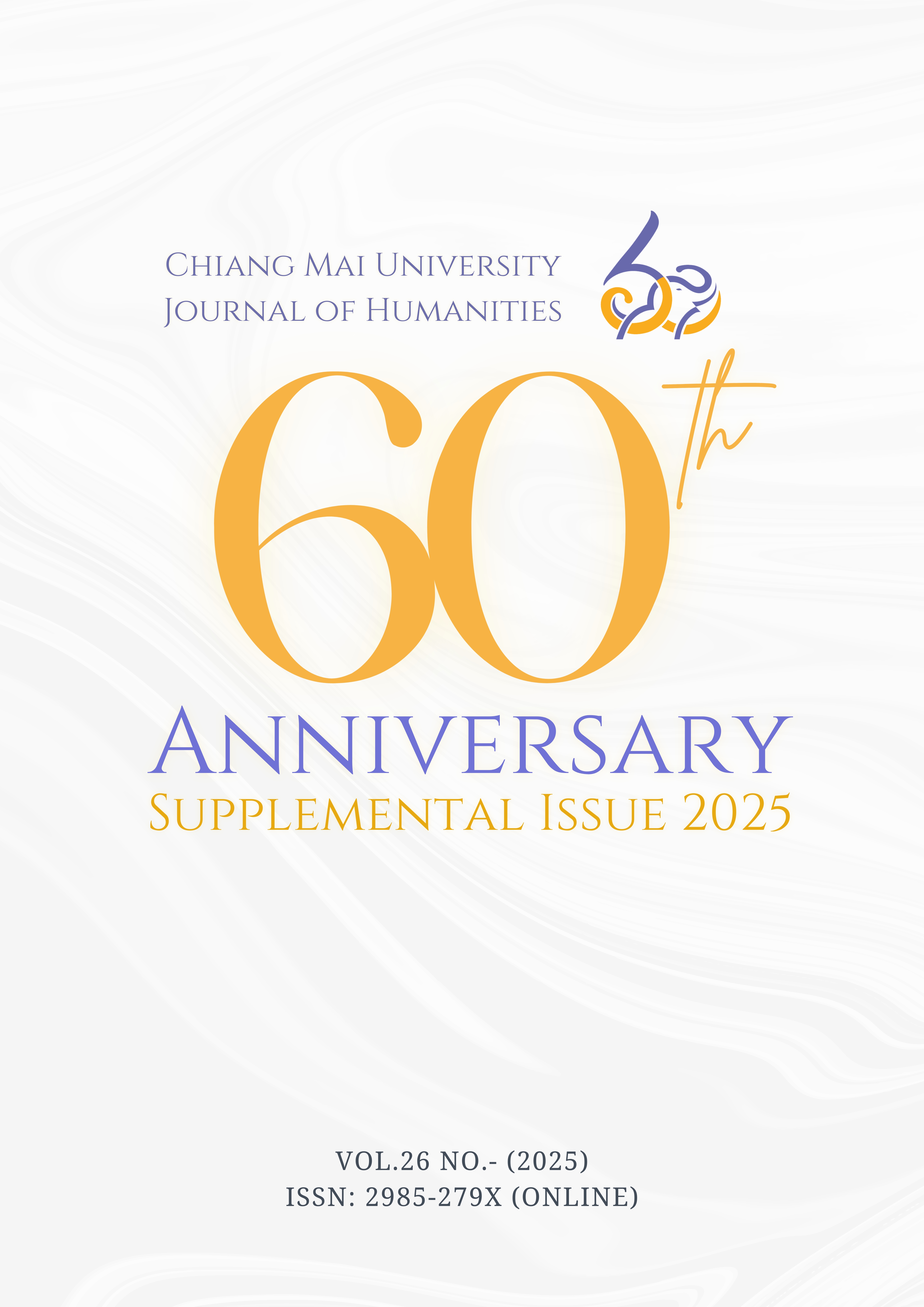Knowledge Elicitation for Spoken English Teaching through the Design Thinking Process
Main Article Content
บทคัดย่อ
As the international lingua franca, English serves as a communication medium for people from diverse linguistic backgrounds. In China, junior high school marks the beginning of systematic English learning for most students. However, spoken English receives insufficient attention, and this phenomenon is particularly evident in public junior high schools. This research employed the five steps of the Empathize-Define-Ideate-Prototype-Test in design thinking to explore challenges and elicit insights for improving current spoken English teaching in public junior high schools in Chengdu. Firstly, the current standard of spoken English teaching was analyzed using a combination of questionnaire data from students and English teachers, which was structured according to the Context, Input, Process, and Product (CIPP) model. Additionally, the key problems and root causes of these problems in current spoken English teaching were identified through thematic analysis of semi-structured interviews with experienced English teachers. Subsequently, divergent information on how to effectively address the identified problems was derived by organizing interview data and reviewing relevant literature. Furthermore, important knowledge was elicited by considering the diverse obstacles faced in spoken English teaching in public junior high schools. Finally, the advantages and applicability of the elicited knowledge were validated through a comparison with the current teaching practices. The findings highlighted the significant gap between the actual practices and ideal standards of spoken English teaching and proposed actionable knowledge to bridge this gap. This research is intended to provide valuable insights for English teachers to enhance their spoken English teaching skills and support the positive development of spoken English education in public junior high schools.
Article Details

อนุญาตภายใต้เงื่อนไข Creative Commons Attribution-NonCommercial-NoDerivatives 4.0 International License.
เอกสารอ้างอิง
Braun, V., & Clarke, V. (2006). Using thematic analysis in psychology. Qualitative Research in Psychology, 3(2), 77-101. https://doi.org/10.1191/1478088706qp063oa
Carlgren, L., Rauth, I., & Elmquist, M. (2016). Framing design thinking: The concept in idea and enactment. Creativity and Innovation Management, 25(1), 38-57. https://doi.org/10.1111/caim.12153
Chen, C. F. (2009). A case study in the evaluation of English training courses using a version of the CIPP model as an evaluative tool (Doctoral dissertation, Durham University).
Chen, Z., & Goh, C. (2011). Teaching oral English in higher education: challenges to EFL teachers. Teaching in Higher Education, 16(3), 333-345. https://doi.org/10.1080/13562517.2010.546527
Cleminson, T., & Cowie, N. (2021). Using design thinking as an approach to creative and communicative engagement in the English as a Foreign Language (EFL) classroom. Journal of University Teaching and Learning Practice, 18(4). https://doi.org/10.53761/1.18.4.7
Darama, E., Karaduman, F., Kahraman, K., & Gündogdu, K. (2018). Evaluation of 5th grade English curriculum according to Stufflebeam’s Context, Input, Process, Product (CIPP) model. International Journal of Psycho-Educational Sciences, 7(2), 73-86. http://files.eric.ed.gov/fulltext/EJ1252947.pdf
Dawadi, S. (2020). Thematic analysis approach: A step by step guide for ELT research practitioners. Journal of NELTA, 25(1-2), 62-71. https://doi.org/10.3126/nelta.v25i1-2.49731
Fan, X. J. (2019). Application of interactive teaching approach to oral English teaching in junior middle schools. Studies in Literature and Language, 19(2), 94-100. https://doi.org/10.3968/11315
Henriksen, D., Richardson, C., & Mehta, R. (2017). Design thinking: A creative approach to educational problems of practice. Thinking Skills and Creativity, 26, 140-153. https://doi.org/10.1016/j.tsc.2017.10.001
Li, S. (2024). The challenges and dilemmas of spoken English education in the context of the compulsory education system in China. Transactions on Social Science Education and Humanities Research, 11, 629-636. https://doi.org/10.62051/w3r18869
Liu, M. (2005). Reticence in oral English language classrooms: A case study in China. TESL Reporter, 38(1), 1-16. https://ojs.lib.byu.edu/spc/index.php/TESL/
article/download/3807/3553
Liu, Z. Y. (2022). A study on the evaluation of oral English teaching in senior high school based on CIPP model [基于 CIPP 模式的高中英语口语教学评价研究] (Master’s thesis, Yanan University).
Nielsen, J. (2000). Why you only need to test with 5 users. Nielsen Norman Group. https://www.nngroup.com/articles/why-you-only-need-to-test-with-5-users/
Nosirova, D. (2023). Learning English as a second language: Challenges and strategies. Modern Science and Research, 2(9), 165-170. https://doi.org/10.5281/zenodo.8356219
Sawalmeh, M. H., & Dey, M. (2023). Globalization and the increasing demand for spoken English teachers. Research Journal in Advanced Humanities, 4(2). https://doi.org/10.58256/rjah.v4i2.1097
Sun, Y. G. (2020). A comparative study of secondary oral English teaching between foreign language training institutions and public schools [外语培训机构与公立学校初中英语口语教学的对比研究] (Master’s thesis, Liaocheng University).
Tang, X. Y. (2017). A study of current state of and countermeasure proposal for oral English teaching in junior middle school (Master’s thesis, Ludong University).
Wang, L. L. (2023). Survey on spoken English ability of middle school students in townships: Taking a junior middle school in Hanzhong as an example. Journal of Education and Educational Research, 5(3), 46-52.
Xu, W., & Zammit, K. (2020). Applying thematic analysis to education: A hybrid approach to interpreting data in practitioner research. International Journal of Qualitative Methods, 19, 1-9. https://doi.org/10.1177/1609406920918810
Yang, S. (2014). Problems and solutions: A survey on oral English teaching in Chongqing Wushan Emigration Middle School [重庆市库区移民中学英语口语教学现状调查问题与对策——以巫山中学为例] (Master’s thesis, Chongqing Normal University).
Zhang, J. (2021). A study on current situation of junior high school spoken English teaching: A case study of a middle school in Xuzhou [初中英语口语教学现状调查研究——以江苏省徐州市某中学为例] (Master’s thesis, Huaibei Normal University).
Zhang, P. W. (2023). Problems encountered by Chinese high school English learners. Journal of Education, Humanities and Social Sciences, 8, 2202-2207. https://doi.org/10.54097/ehss.v8i.4677
Zhang, Y. J. (2022, February). A review of the problems and the solutions in middle school oral English teaching in China. In 2021 International Conference on Education, Language and Art (ICELA 2021) (pp. 581-585). Atlantis Press. https://doi.org/10.2991/assehr.k.220131.105


